Foreword
It all started with ‘can we run a UBUC trip to the Philippines’. We spent weeks trying to work out how this could happen. Unfortunately, we felt that due to logistics we had to keep the group size small. Turning up in a new place without booking anything can be quite an ordeal and with the weather in June / July time being very unpredictable (we missed one storm by a week and the Typhoon thankfully missed the Philippines as we were leaving), we were unsure as to whether we might get stuck on various islands.
Pictures + Videos
All pictures were taken by Jess. Videos are a combination of Chris and Ivan’s GoPro footage.
Map of our travels
Quick Reference
Conversion rate at the time of writing – £1 = 70 pesos.
Bangka – A type of Filipino boat, made of wood and always featuring outriggers.
Jeepney – An elongated jeep used for cheap transportation. Normally brightly coloured.
Trike – A tricycle, normally has a cover over the passenger in case of rain. Yes, you can fit 5 people plus bags on one trike, although it may tip over backwards.
Puerto Galera (Sabang) – the Center of the Center of Marine Shorefish Biodiversity
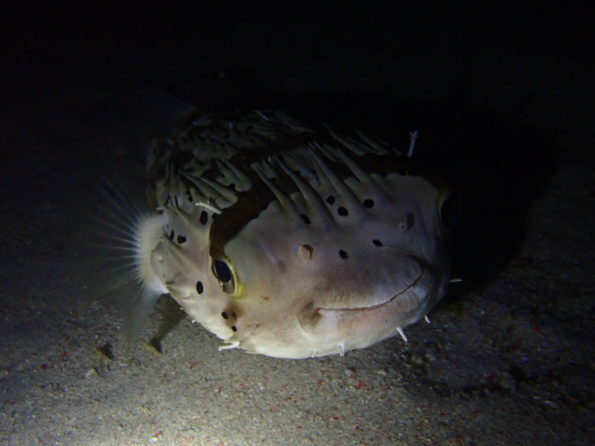
HELLO I’M A PORCUPINE FISH
We started our trip in Manila, staying at Cozy Dito Hostel. It was quite difficult to find and to be honest, I’d recommend staying at Pink Manila which is on the floor above and about 70 pesos more expensive per night. However, the hostel suited us for what we wanted which was somewhere to meet and crash for the night as we all had different flights.
We took a bus south from JAM Liner Bus Station the next morning at around 8am. It took 2 hours to get to Batangas, at which point we took a ferry across to Sabang. This is the main dive area of Puerto Galera. We were immediately greeted by a group of women who were trying to get us to stay at their (or friend’s?) place. We tried to ignore them and just walked around Sabang, but after a bit of persuasion they took us to a place that suited us well and was relatively cheap (400 pesos pp a night). We also checked out the dive centres and found that Sabang Fun Divers (run by a Russian to which everything was ‘no problem’) seemed to offer the cheapest prices (900 pesos a dive).
We dived an afternoon dive on a very tiny wreck in the middle of the bay, which was ok as a first dive but nothing mind blowing. We also did a night dive that evening which was OK and a good chance to ensure our torches and other lights were working.
The next day we went out for 2 dives on Isla Verde (Verde Island), which was declared the “Center of the Center of Marine Shorefish Biodiversity” in 2006, although it is still not a protected site. The main site that is dived is a large pinnacle, and it can be pretty currenty (it was for us!). The two dives involved diving each side of the pinnacle. The corals are fantastic, and there were so many fish it was difficult to identify them all (though we had a good go!)
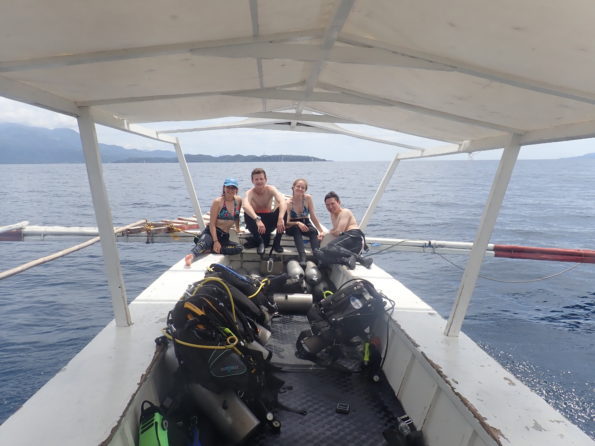
On the boat by Verde Island
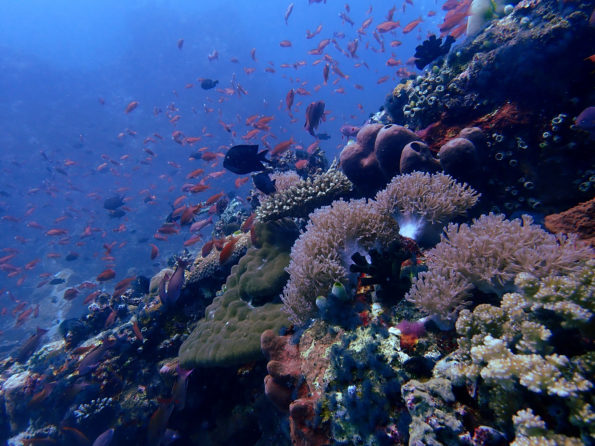
All the biodiversity
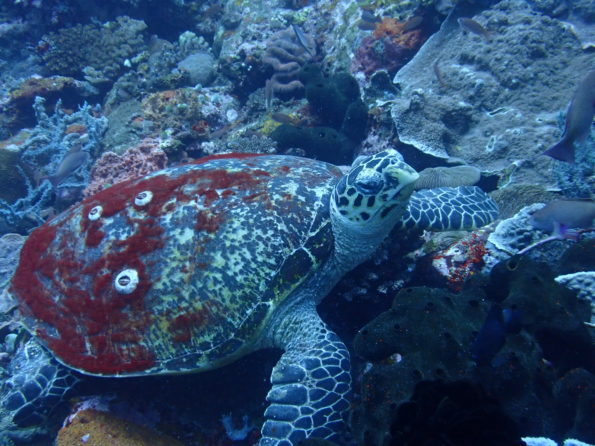
Turtle!
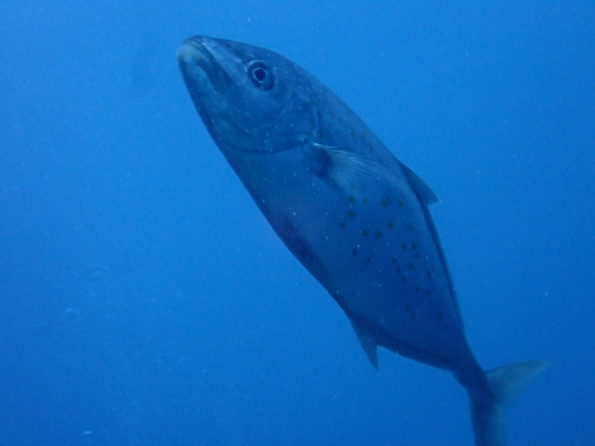
Jack
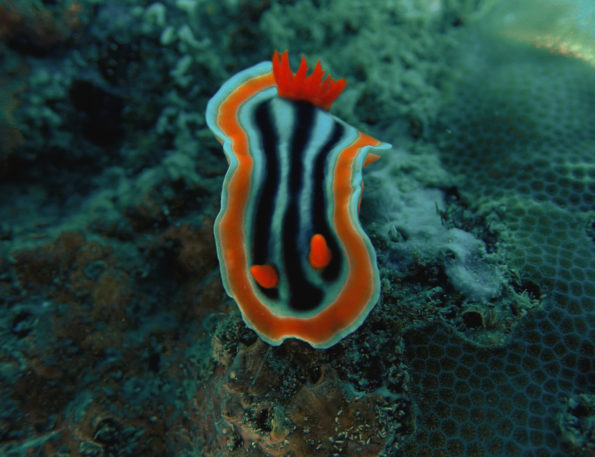
Nudi!
Coron – A Japanese Fleet
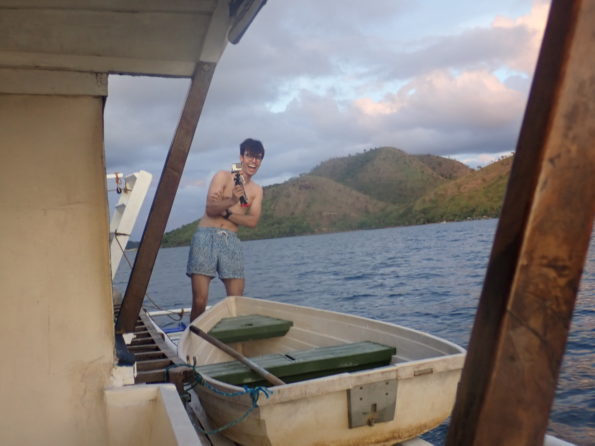
Ivan appears!
To get to Coron, we decided to take the overland route through Mindoro instead of flying. It was quite a journey. We started by taking a jeepney to Puerto Galera, followed by another jeepney to Calapan. From there, we were stuffed into a series of minibuses that took us to Roxas, and then another series of minibuses that took us round to San Jose. As we arrived so late, we had to stay a night there at Savedra Beach Resort, which is a little out of town but not too far from the ferry port. We got a trike into town that evening so we could eat cheaply, instead of eating at the hotel. The next morning we took a trike to the port (early, around 6am) where to our horror we discovered that the only ferry that runs to Coron was full for that day. We stressed around a little and walked up and down the port trying to see if there were any other companies that went (there weren’t) and so just had to wait it out. Thankfully it seems there were 4 no shows as about an hour and a half later we were handed tickets. Phew! The ferry is a bangka and took around 6.5 hours to reach Coron. Quite a long one, especially when it started to rain as the window shutters were closed and we all started to suffocate from the fruit fumes.
We had a quick wander around Coron and found that Coron Backpacker’s Hostel (tucked above the water down quite a hairy looking alleyway) was offering the cheapest prices to stay and is also a really nice place on the inside.
We dived with two dive centres, the first being Coron Divers and they were cheap, and then the day after with French Kiss Coron as we knew one of the dive guides there (the prices turned out about the same anyway).
On the first day we dived Barracuda Lake, which is thermal and gets to almost 40 degrees as you descend (it gets hard to breath here!) Imagine a hot quarry, as there isn’t much else there. The only interesting part was at the end where we messed around in 6m of water ‘climbing up’ things and having our hands cleaned by the cleaner shrimp.
We then dived two wrecks, the first being the Morazan Maru and the second the East Tangat Wreck. The Morazan is on its side and has large holds, and is an ideal beginner dive for wreck penetration. East Tangat is a very small ship that almost breaks the surface. Unfortunately it was coated in divers probably due to most of the dive centres using it as an easy second dive, so all the swim throughs were pretty clogged up.
On the second day we went out early with French Kiss Divers to their secluded dive boat which is moored away from the main harbour, and set off northwards. We did 3 penetration dives, the first on the Akitsushima, the second on the Kogyu Maru and the third on the Olympia Maru.
After diving, we spent another day doing an ‘Island Hopping’ tour around Coron Island (I use quotes as all the places we visited were on the same island..) It’s cheapest to do this by just going down to the port in the morning – there will always be someone who will be willing to take you out for much less than a tour company would cost (assuming you have a reasonable sized group to split the boat cost between). We spent one more day in Coron afterwards, recovering from a bout of food poisoning. We visited King Fisher Park where we did a little bit of kayaking through the mangroves, and saw a horseshoe crab that had been tied up (‘dinner’).
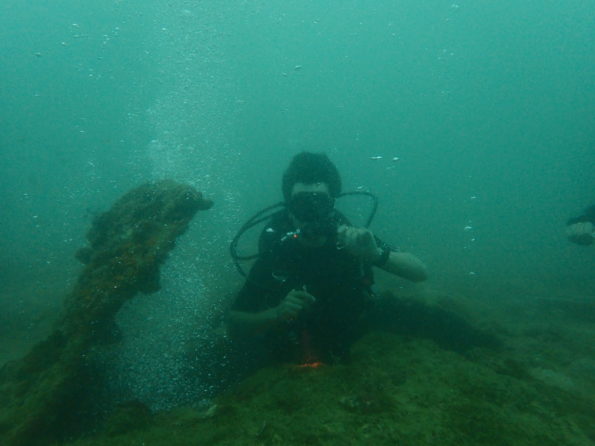
Mmm dat vis. Ivan on a wreck.
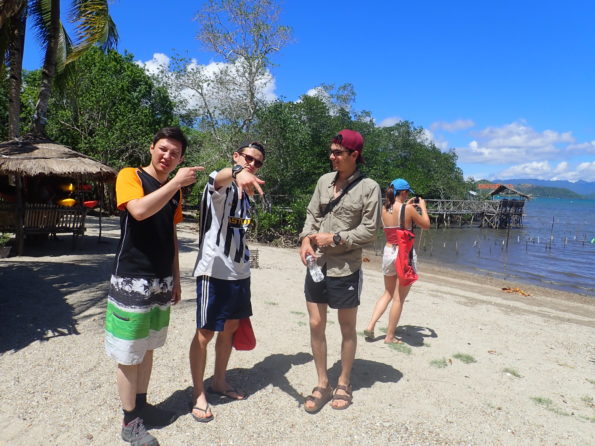
Beach!
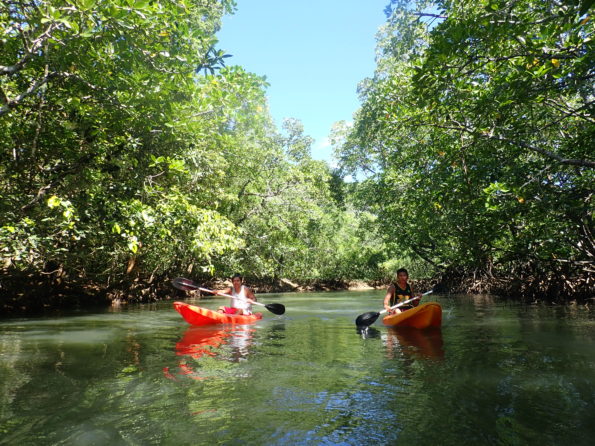
Kayaking
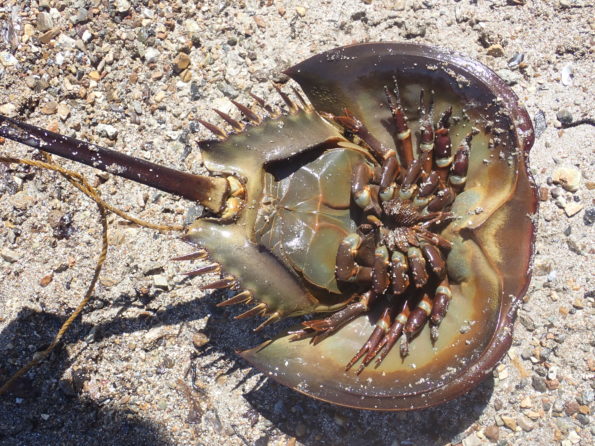
‘Dinner’
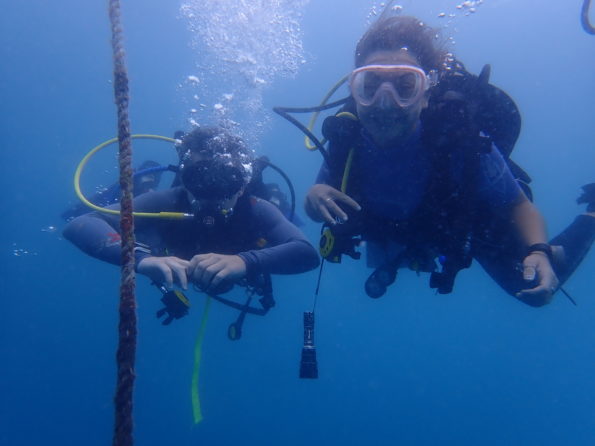
Decompressing…
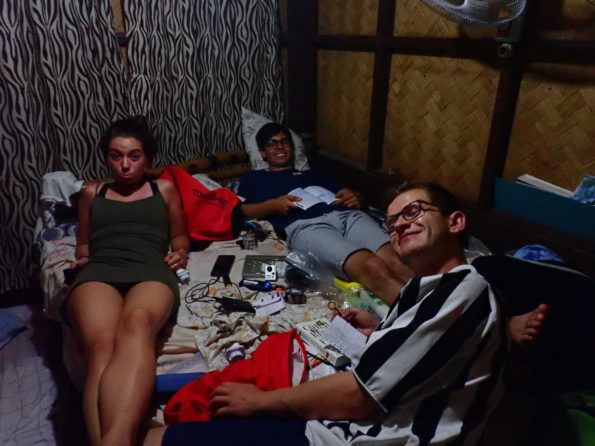
Coron Backpackers Hostel
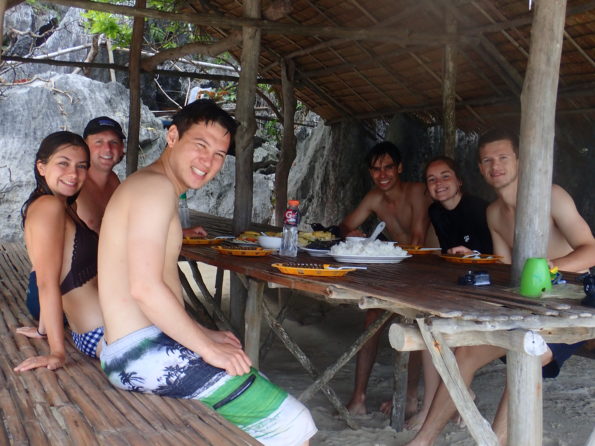
Lunch time on our ‘Island Hopping’ tour
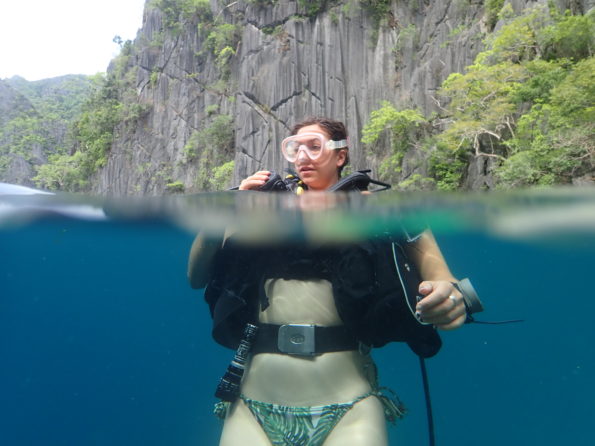
This.
Apo Island – Drift Dives with beautiful corals and turtles galore
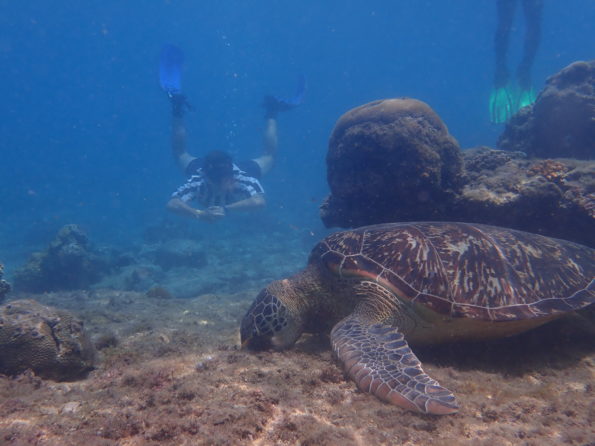
Snorkelling with turtles
The original plan after Coron was to take a boat to El Nido, but we decided instead to skip this and head straight to Apo Island instead as we were short on time for one of the divers. We thus took an early morning minibus (takes about 20 minutes driving maniacly) to the airport and caught an early flight to Cebu. We were charged a little for baggage but as we were a group they did it over the whole group and were pretty relaxed about it. The flight arrived early in Cebu so we had time to get to the South Bus Terminal by van and jump on a bus heading to Dumaguete. The journey includes a ferry which is not included in the ticket price.
We stayed a night in Dumaguete (‘Duma’) at Harold’s Mansion before getting an early morning trike to the jeepneys and then a jeepney to Malatapay. We could then get a (quite expensive – 600 pesos each for the round trip) ferry across to Apo Island. Note there is no pier on either side, so best to wear shorts and flip flops as wading will happen!
Once on Apo we went to Liberty Lodge and stayed at the dorm (300 pesos pp a night, but doesn’t include any food). It was HOT in the room though, so be prepared for that. The electricity stops at 10pm so no fans, and ensure you have a torch in the evening if you’re out and about!
We dived with Liberty Divers which is part of the hotel, although some of their dive practices seem a little sketch.
The first site we dived was a small drift dive around Rock Point West, which we dived that afternoon that we arrived. This was quite a nice one and showed off the corals beautifully, unfortunately there was a bit of an upset at the end of the dive where the DM tried to swim against a current whilst having one of the divers use his secondary as the guy was pretty much out of air. Not sure why the DM thought this was a good idea, it would have been better just to surface especially as they were only a few metres underwater!
The second dive was the next morning on the classic Coconut, a spectacular drift dive over beautiful coral with many sea snakes, and ending with a large group of big-eyed trevallys (NOT jacks). The third dive was a nice and gentle ‘muck’ dive on Largahan, along a reef and an almost 45 degree sloping wall of sand, plus volcanic bubbles. The last dive was a night dive in Chapel (shore diveable) where we saw many sleeping turtles and had one try and swim into us as it went to the surface for air.
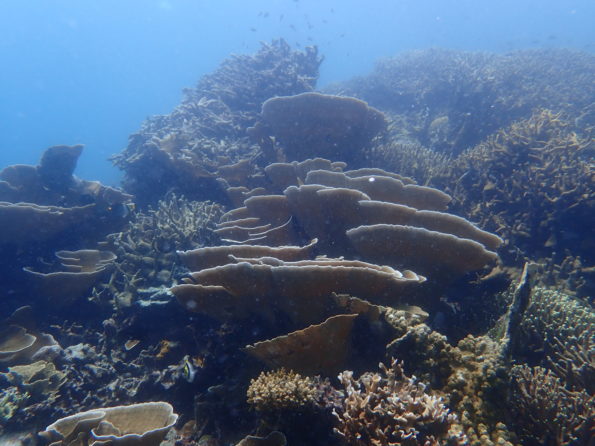
Corals
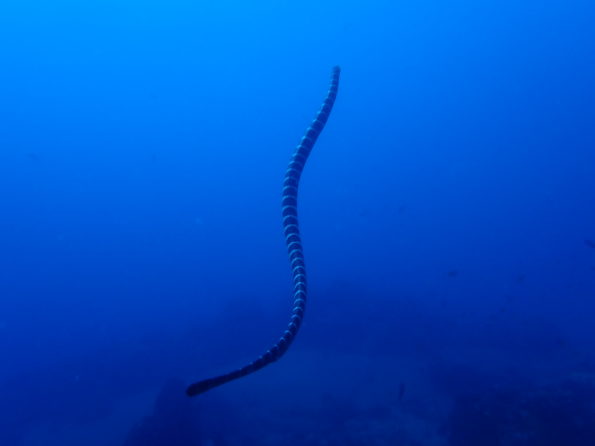
SEA SNAKE!!!
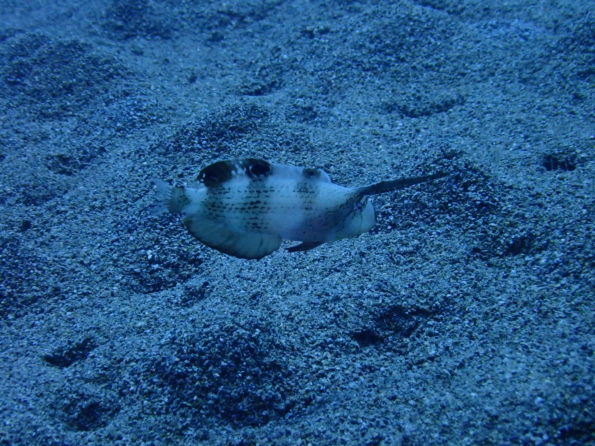
Juvenile Indian Fish
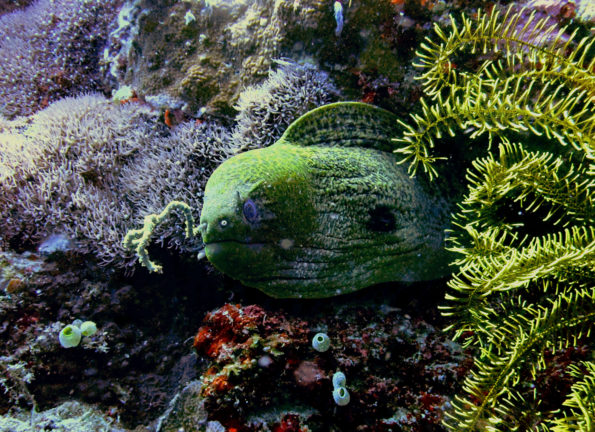
Moray Eel
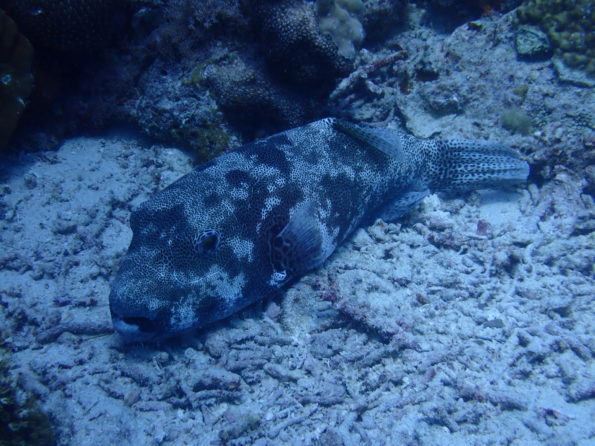
Giant Puffer Fish
Moalboal – Had enough sardines yet?
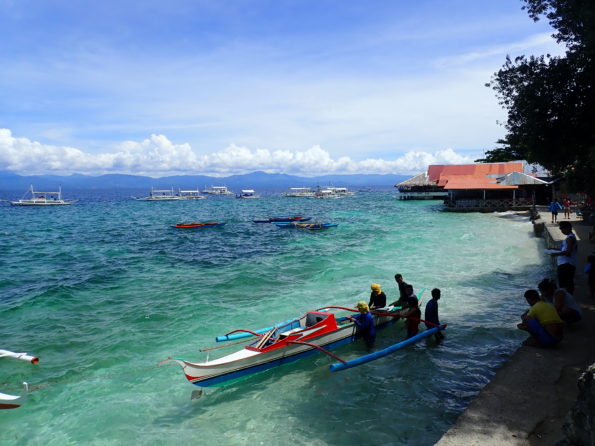
The Moalboal Shoal (located at the end of where the huts are)
After Apo, we took the ferry back to Malatapay and then a jeepney back to the main bus terminal. From there we took a bus to Amlan and then a ferry across to Bato Port, which didn’t leave until 2pm so we had plenty of time for lunch. After that, another bus to get us up to Moalboal and then a trike to actually get us to where we wanted to stay (at Panagsama, which is where most of the dive centres are located and also where the main dive site is).
We went for a swim the next morning along the wall where the sardines live, mainly to decide whether we wanted to dive there or not. We decided we did, and we managed to find a dive centre (see info box) that would rent us just cylinders and lead for 300 pesos each, so cheap diving the four of us had with the sardines! There’s millions of them and they make some cool patterns, especially if you shine your torch at them. The wall is also quite cool and has a lot of life on it. There were a few predators hunting the sardines but mainly seemed to be large needlefish.
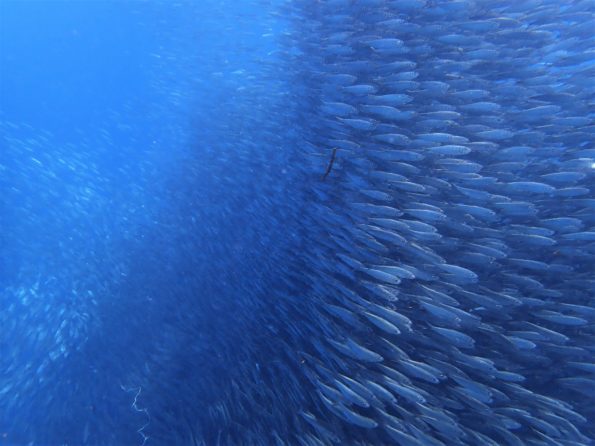
All the sardines
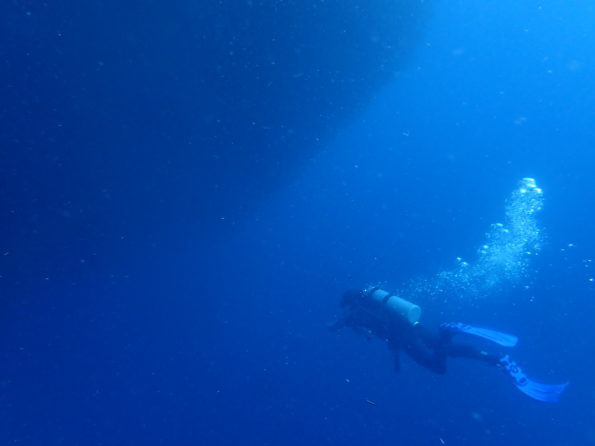
Even more sardines
Malapascua – Sharks (Threshers and white tips)
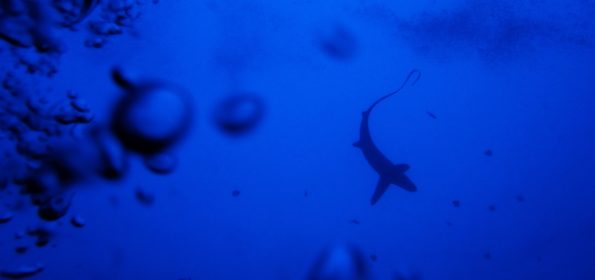
Thresher Shark
After just the one dive at Moalboal and deciding to skip doing anything else, we caught a (very early, 6am) bus back to Cebu South Bus Terminal and from there got a taxi to the North Bus Terminal and a bus to Maya. From the port we took a bangka across to Malapascua.
As we had already dived with French Kiss in Coron, they were offering us a discount so we went with them again (we also got to dive just as the 4 of us and no one else, which was much better). We got to Malapascua quite late so didn’t do any diving that day. Instead we did a morning (9am) dive on a slightly currenty site (Lapus Lapus) looking for seahorses (didn’t see any) and then a night dive at Lighthouse looking for seahorses (found some this time!).
During the day we stayed at our hostel Villa Sandra for the morning, and then in the afternoon were persuaded by the guy who owned the hostel to go on a snorkelling trip. Unfortunately the starter motor rope snapped and so we were marooned at sea for about half an hour until another boat appeard with the correct tool, by which then two of the other people on the boat had gone snorkelling again, got caught in a current and were drifting off to sea so we had to go rescue them. Bit of a disaster, all told. We then did a bit more rubbish snorkelling and then went back to the dive centre for the night dive.
The next morning we dived the classic Monad Shoal (along with ~30 other people) to see the thresher sharks. We definitely weren’t disappointed, and being the first people on the site meant that we had it all for about 10 minutes. With threshers swimming above us it was quite the spectacle as were the other divers when they all descended… (seriously, were they doing PADI DSDs on the site?! Because that’s what some of the divers looked like to me). The site is 30m so Nitrox is a must to have any reasonable bottom time.
We then headed over to Gato Island, which is the other famous site on Malapascua and is where you can find white tip reef sharks. Again, definitely not disappointed as we saw them out on the reef as well as tucked away inside caves and under rocks. Probably about 4 or 5 were spotted during the two dives. There is a small cave system that runs partially through Gato Island which was quite cool to dive through (and had a shark living in it, although we think it was a catshark and not a white tip) plus nice dropoffs and reefs. A memorable event was the mantis shrimp that looked like it was trying to defend its burrow from us, plus a large cuttlefish, some eels and a nice group of squid.
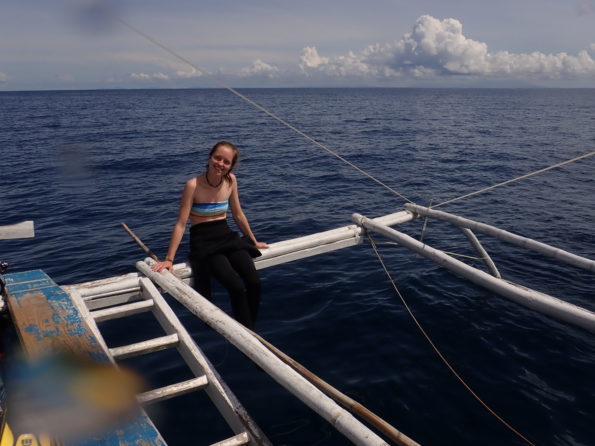
Jess on the boat at Gato Island
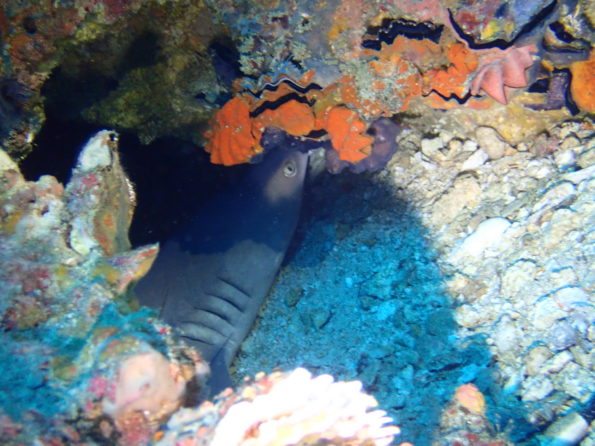
White tip reef shark
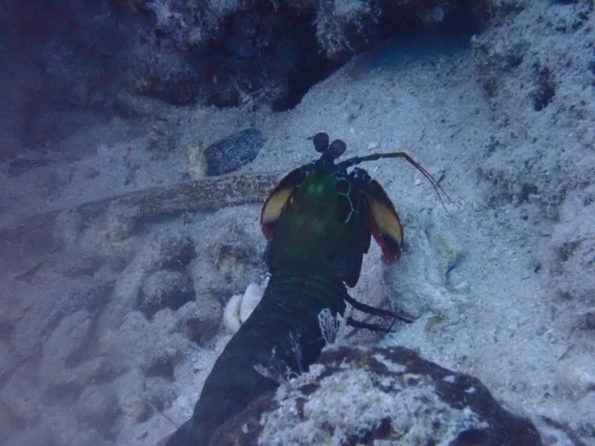
Mantis shrimp
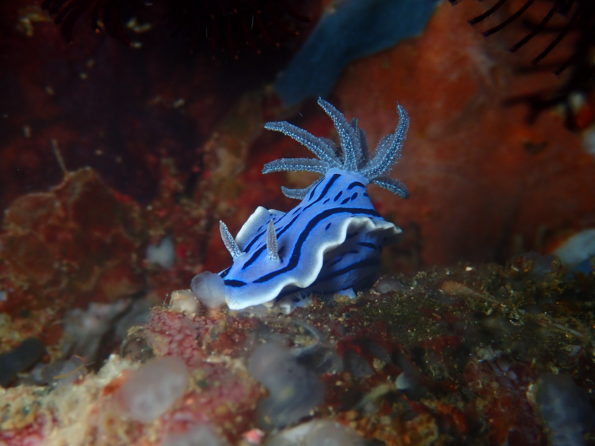
Nudibranch
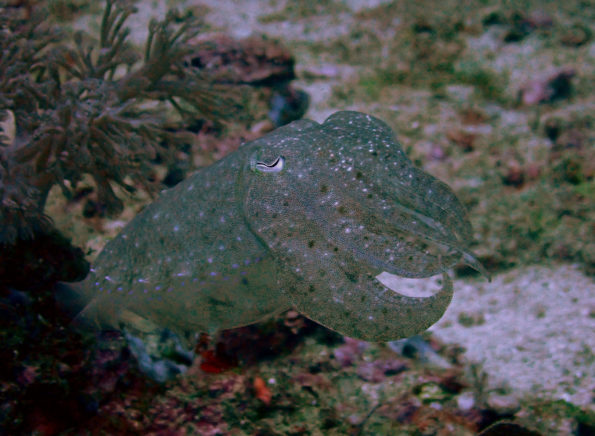
Cuttlefish
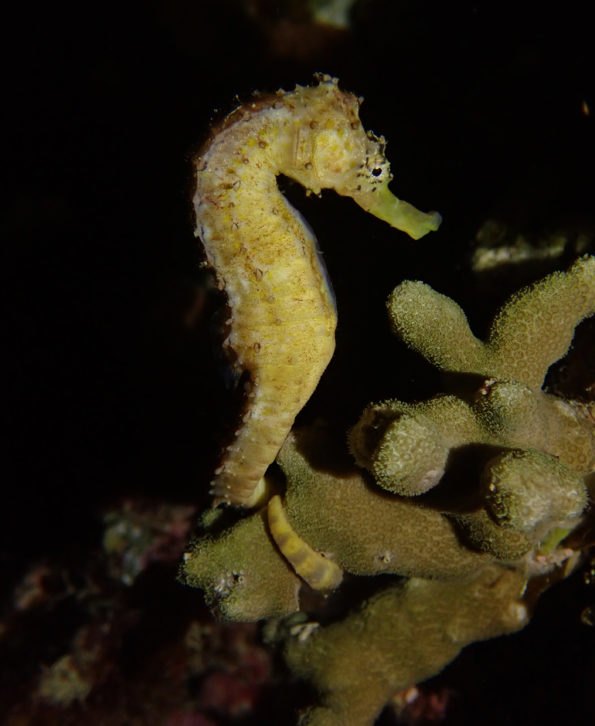
Seahorse!
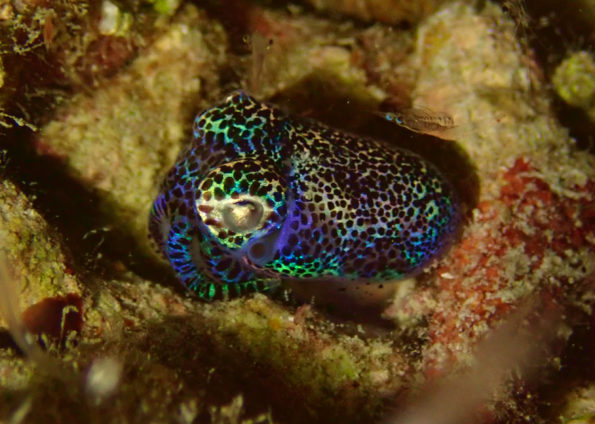
Bobtail Squid
Ticao – Manta Bowl
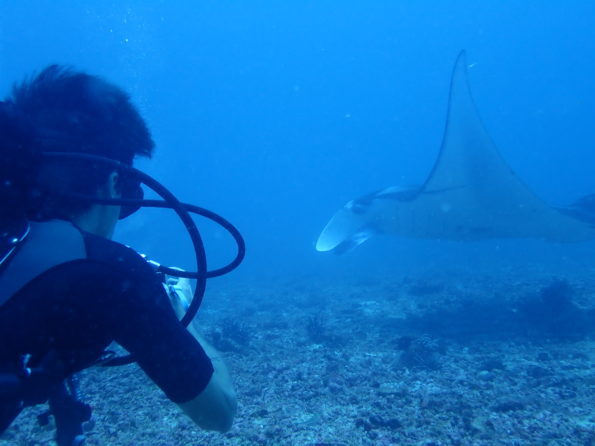
Ivan with a manta ray
After Malapascua, it was on to our final destination of Ticao, a place that seemingly no one has heard about if you live in Cebu. To get there we first had to get the ferry back to the mainland, and then we grabbed a jeepney that took us to near the ferry terminal at Polambato. From there we got a trike to the ferry. The ferry runs from Polambato to Cataingan and leaves at midnight, meaning we had a long time in between as the last ferry leaving Malapascua is around 2pm. The overnight ferry arrives at around 6am. Taking a minibus to Masbate, we then got a trike to the ‘fish port’ (and had a small worry when half of the guys were taken to the wrong port down the road – turns out there are two even though we asked!). A ferry of about 2 hours took us to Lagundi Port. We then got a bus to San Jacinto and lastly each rode a motorbike to our final destination, Ticao Island Resort (TIR). What a hassle, but it was definitely worth it.
At TIR we stayed in the budget rooms (around 450 pesos pp per night) which didn’t include food, although as you can’t really eat anywhere else it was reasonably priced (150 to 250 pesos a meal). Pancit TIR was definitely the order of the day! You might be able to pick up something cheaper in the villages either side of TIR but we didn’t try to find out.
Ticao’s main selling dives are the Manta Bowl, where you can see manta rays. There are also other sites such as Tuna Alley, although you need a strong current for this which we didn’t have during our stay. They also offer trips to see the whale sharks although it was out of season when we were there so we didn’t go. We dived Manta Bowl twice which was amazing. It’s no more than 20m and can be very currenty so everyone is equipped with reef hooks to stop yourself being dragged off the top of the site and over the sides, which plunge down to 400m+. We however had 2 dives with no current at all, which was very relaxing. During both dives we saw manta rays. When you see one, you immediately drop to the floor and wait to see if the manta will ‘accept you’. They definitely seemed to as we got really close up to them. The nice thing about Manta Bowl was that unlike Malapascua where there can be hundreds of divers on the same site, there was only us and 3 other divers in a separate group that day. Bliss.
After Manta bowl, we dived at San Miguel which was a nice change although pretty much a standard wall dive. There were electric clams though, which were pretty awesome!
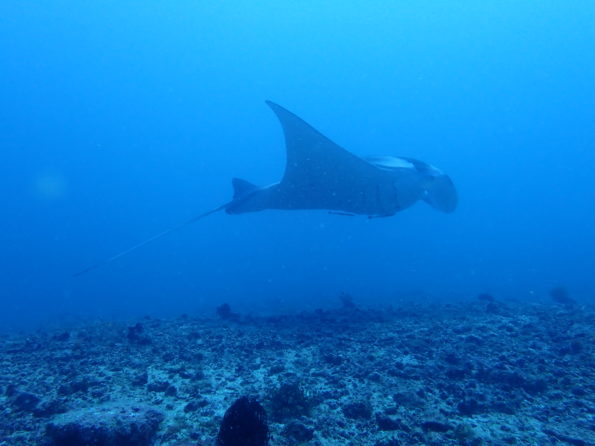
Manta Ray!
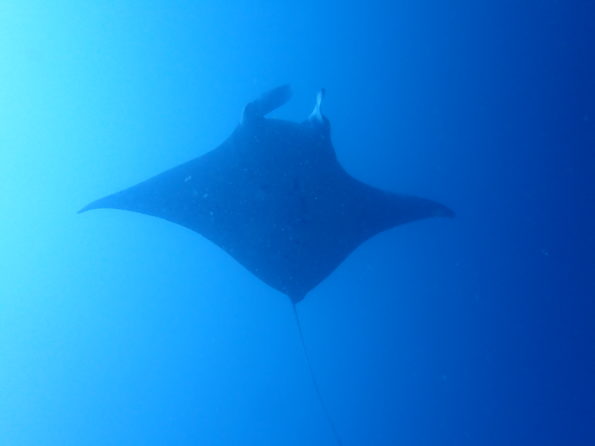
Manta Ray!
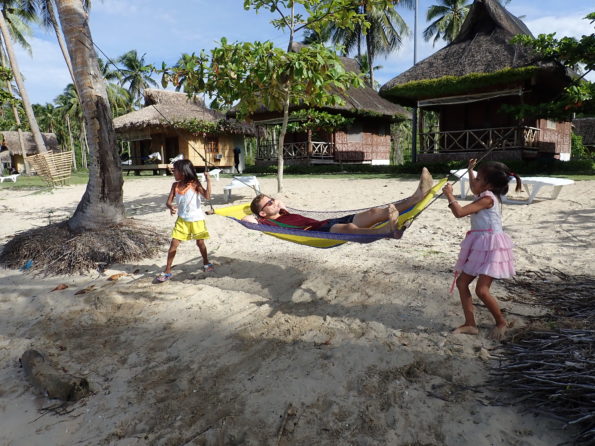
For some reason this was very funny
Back to Manila…
To get back to Manila, we decided as we had time to take the overland route which is cheaper than flying, although takes considerably longer. We took motorbikes once again to the ferry port in Monreal to Pilar. On the other side, a short minibus ride (of which they tried accusing us we hadn’t paid enough – ‘690!!’) took us to Legazpi. From there we got a late bus back to Manila, the main bus terminal conveniently located next to the minibus terminal although the ticket offices are tucked in one corner on the main road side of the bus station. Tickets were around 1000 pesos each depending on what class you get. The bus was about 11 hours long but it was freezing and as usual, the driver was a maniac involving lots of acceleration immediately followed by hard braking, so sleep was not as much as was desired.
Groggily we ended up back in Manila where we spent a few nights at Hometown Hotel. We spent the rest of the day at the water park Splash Island which was OK for 350 pesos each but a bit of a pain to get to and back again.
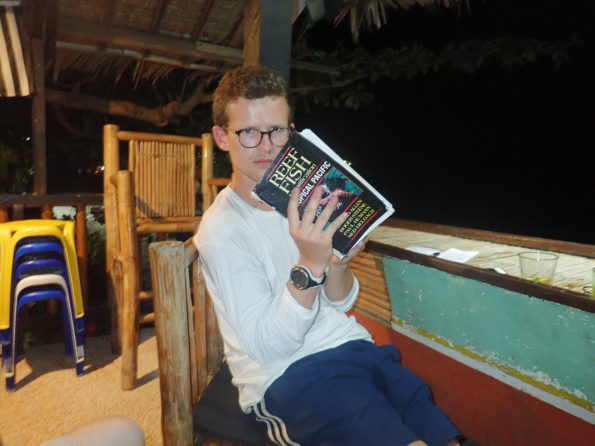
Every evening.
(For the Future) Subic Bay – U.S. Battleship, among plenty of others
Sadly we didn’t actually reach Subic Bay due to 2 / 3 of us getting ill with food poisoning and forcing us to stay in Manila. If you get a chance, take the 4 hour bus journey and let us know how it went!
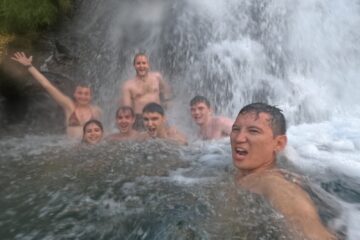
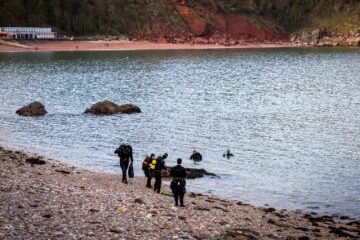
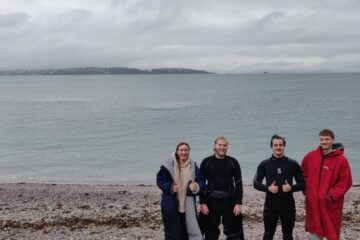
0 Comments